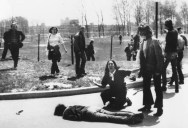This Day In History – May 4th

RHODE ISLAND FIRST COLONY TO RENOUNCE ALLEGIANCE – MAY 4, 1776

Aerial of Providence, Rhode Island – Photograph by Rhode Island State Archives
Rhode Island was the first of the original thirteen colonies to declare its independence from Great Britain (May 4, 1776), and the last to ratify the Constitution, doing the latter only after being threatened with having its exports taxed as a foreign nation.
Rhode Island’s tradition of independence and dissent gave it a prominent role in the American Revolution. In 1772, the first bloodshed of the American Revolution took place in Rhode Island when a band of Providence residents attacked a grounded British ship for enforcing unpopular British trade regulations. This incident would come to be known as the Gaspee Affair.
During the Revolution, the British occupied Newport. A combined Franco-American force fought to drive them off of Aquidneck Island. Portsmouth was the site of the first African American military unit, the 1st Rhode Island Regiment, to fight for the U.S. in the Battle of Rhode Island August 29, 1778. The arrival of a far superior French fleet forced the British to scuttle their own ships, rather than surrender them to the French. [Source: Wikipedia]
US CONSTRUCTION BEGINS ON THE PANAMA CANAL – MAY 4, 1904

Photograph by J. David ROgers
The Panama Canal is a 77-kilometre (48 mi) ship canal in Panama that joins the Atlantic Ocean and the Pacific Ocean and is a key conduit for international maritime trade. Built from 1904 to 1914, over 815,000 vessels have passed through the canal. It has been named one of the seven modern wonders of the world by the American Society of Civil Engineers.
One of the largest and most difficult engineering projects ever undertaken, the canal had an enormous impact on shipping between the two oceans, replacing the long and treacherous route via either the Strait of Magellan or Cape Horn at the southernmost tip of South America. A ship sailing from New York to San Francisco via the canal travels 9,500 km (5,900 mi), well under half the 22,500 km (14,000 mi) route around Cape Horn.
The concept of a canal near Panama dates to the early 16th century. The first attempt to construct a canal began in 1880 under French leadership, but was abandoned after 21,900 workers died, largely from disease (particularly malaria and yellow fever) and landslides. The United States launched a second effort, incurring a further 5,600 deaths but succeeding in opening the canal in 1914. The U.S. controlled the canal and the Canal Zone surrounding it until the 1977 Torrijos–Carter Treaties provided for the transition of control to Panama. From 1979 to 1999 the canal was under joint U.S.–Panamanian administration, and from 31 December 1999 command of the waterway was assumed by the Panama Canal Authority, an agency of the Panamanian government. [Source: Wikipedia]

Construction of locks on Panama Canal, 1913 – Photograph by Thomas Marine

The Culbera Cut of the Panama Canal, 1907 – Photograph via Wikimedia Commons
THE MAY FOURTH MOVEMENT AT TIANANMEN SQUARE – MAY 4, 1919

Photograph via Swire Travel
The May Fourth Movement was an anti-imperialist, cultural, and political movement growing out of student demonstrations in Beijing on May 4, 1919, protesting the Chinese government’s weak response to the Treaty of Versailles. These demonstrations sparked national protests and marked the upsurge of Chinese nationalism, a shift towards political mobilization and away from cultural activities, and a move towards populist base rather than intellectual elites. The broader use of the term “May Fourth Movement” often refers to the period during 1915-1921 more usually called the New Culture Movement.
Scholars rank the New Culture and May Fourth Movements as significant turning points, along with the abolition of the civil service system in 1905 and the overthrow of the monarchy in 1911. In its broader sense, the May Fourth Movement led to the establishment of radical intellectuals who went on to mobilize peasants and workers into the Communist party and gain the organizational strength that would solidify the success of the Communist Revolution. [Source: Wikipedia]

Photogarph by CBenitez
AL CAPONE BEGINS PRISON SENTENCE FOR TAX EVASION – MAY 4, 1932

Photograph by United States Department of Justice
Alphonse Gabriel “Al” Capone (January 17, 1899 – January 25, 1947) was an American gangster who led a Prohibition-era crime syndicate. Known as the “Capones”, the group was dedicated to smuggling and bootlegging liquor, and other illegal activities such as prostitution, in Chicago from the early 1920s to 1931.
Born in Brooklyn, New York to Italian immigrants, Capone became involved with gang activity at a young age after being expelled from school at age 14. In his early twenties, he moved to Chicago to take advantage of a new opportunity to make money smuggling illegal alcoholic beverages into the city during Prohibition. He also engaged in various other criminal activities, including bribery of government figures and prostitution. Despite his illegitimate occupation, Capone became a highly visible public figure. He made various charitable endeavors using the money he made from his activities, and was viewed by many to be a “modern-day Robin Hood”.
However, Capone gained infamy when the public discovered his involvement in the Saint Valentine’s Day Massacre, which resulted in the death of seven of Capone’s rival gang members. Capone’s reign ended when he was found guilty of tax evasion, and sent to federal prison. His incarceration included a stay at Alcatraz federal prison. In the final years of Capone’s life, his mental and physical health deteriorated due to neurosyphilis, a disease which he had contracted earlier. On January 25, 1947, he died from cardiac arrest after suffering a stroke. [Source: Wikipedia]

Al Capone’s Jail Cell at Easter State Penitentiary as it exists today – Photograph by Thesab
THE SUPERGA AIR DISASTER – MAY 4, 1949

The Superga air disaster took place on Wednesday, 4 May 1949, when a plane carrying almost the entire Torino A.C. football squad, popularly known as Il Grande Torino, crashed into the hill of Superga near Turin killing all 31 aboard including 18 players, club officials, journalists accompanying the team, and the plane’s crew.
The emotional impact the crash made on Italian sports fans was profound, as it claimed the lives of the players of a legendary team which had won the last Serie A title before the league play was interrupted in 1944 by World War II and had then returned after the conflict to win four consecutive titles (1946–1949).
At the time of the crash, Torino A.C. was leading Serie A with four games left to play in the season. The club carried on by fielding its youth team (Primavera) and in a sign of respect their opponents in each of these matches (Genoa, Palermo, Sampdoria, and Fiorentina) also fielded their youth sides. Primavera won each of the matches and the scudetto. The disaster seriously weakened the country’s national side which had included up to 10 Torino players. Torino itself would not claim another title until 1976. [Source: Wikipedia]

THE KENT STATE SHOOTINGS – MAY 4, 1970

Photograph by John Paul Filo – Pulitzer Prize, 1971
The Kent State shootings—also known as the May 4 massacre or Kent State massacre—occurred at Kent State University in the city of Kent, Ohio, and involved the shooting of unarmed college students by members of the Ohio National Guard on Monday, May 4, 1970. The guardsmen fired 67 rounds over a period of 13 seconds, killing four students and wounding nine others, one of whom suffered permanent paralysis.
Some of the students who were shot had been protesting against the American invasion of Cambodia, which President Richard Nixon announced in a television address on April 30. Other students who were shot had been walking nearby or observing the protest from a distance.
There was a significant national response to the shootings: hundreds of universities, colleges, and high schools closed throughout the United States due to a student strike of four million students, and the event further affected the public opinion—at an already socially contentious time—over the role of the United States in the Vietnam War. [Source: Wikipedia]

Photograph via Circumboreal

Photograph via Circumboreal
THATCHER BECOMES FIRST FEMALE PRIME MINISTER – MAY 4, 1979

Margaret Thatcher in Brussels, Belgium 1977 – Photograph by NATO
Margaret Hilda Thatcher, Baroness Thatcher, (born 13 October 1925) is a former Prime Minister of the United Kingdom who served from 1979 to 1990. Born in Grantham, Lincolnshire, Thatcher studied chemistry at Somerville College, Oxford before qualifying as a barrister. In the 1959 general election she became MP for Finchley. Edward Heath appointed Thatcher Secretary of State for Education and Science in his 1970 government. In 1975 she was elected Leader of the Conservative Party, the first woman to head a major UK political party, and in 1979 she became the UK’s first female Prime Minister.
After entering 10 Downing Street Thatcher was determined to reverse what she perceived as a precipitous national decline. Her political philosophy and economic policies emphasised deregulation, particularly of the financial sector, flexible labour markets, the sale or closure of state-owned companies, and the withdrawal of subsidies to others. Thatcher’s popularity waned amid recession and high unemployment, until economic recovery and the 1982 Falklands War brought a resurgence of support resulting in her re-election in 1983.
Thatcher survived an assassination attempt in 1984, and her hard line against trade unions and tough rhetoric in opposition to the Soviet Union earned her the nickname of the “Iron Lady”. Thatcher was re-elected for a third term in 1987, but her Community Charge was widely unpopular and her views on the European Community were not shared by others in her Cabinet. She resigned as Prime Minister and party leader in November 1990 after Michael Heseltine’s challenge to her leadership of the Conservative Party.
Thatcher holds a life peerage as Baroness Thatcher, of Kesteven in the County of Lincolnshire, which entitles her to sit in the House of Lords. [Source: Wikipedia]

Photograph by White House Photographic Office
Ronald Reagan’s Cabinet and Margaret Thatcher’s Ministry meet in the White House Cabinet Room. A large jar of jelly beans sits prominently on the cabinet room table during Reagan’s presidency. [Feb. 26, 1981]

Sign up to get our BEST stories of the week straight to your inbox.




